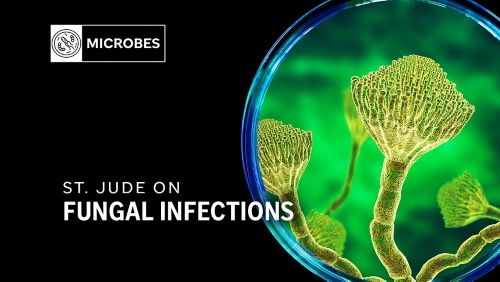St. Jude Family of Websites
Explore our cutting edge research, world-class patient care, career opportunities and more.
St. Jude Children's Research Hospital Home

- Fundraising
St. Jude Family of Websites
Explore our cutting edge research, world-class patient care, career opportunities and more.
St. Jude Children's Research Hospital Home

- Fundraising
Addressing fungal infections will take a medical mycology moonshot

The onset and steady growth of drug resistance has been a concern since the development of antimicrobial therapeutics. While accepting the 1945 Nobel Prize for the discovery of penicillin, Alexander Fleming warned: “The time may come when penicillin can be bought by anyone in the shops. Then there is the danger that the ignorant man may easily underdose himself and, by exposing his microbes to nonlethal quantities of the drug, make them resistant.” However, drug resistance is not a phenomenon reserved for bacteria. Treatment-resistant fungal infections are a growing, but still underappreciated, worry.
While estimates are inexact, recent data collected from 120 countries suggests an annual incidence of 6.5 million invasive fungal infections, largely in immunocompromised individuals with a severe underlying disease. Of this, a stark 2.5 million deaths have been directly attributable to such infections. A quiet battle has been ongoing between fungal infections in immunocompromised patients and the scientists and clinicians seeking to stem the rising tide. At St. Jude Children’s Research Hospital, the vulnerable nature of children undergoing cancer treatment means that addressing antifungal resistance and the progression of new and concerning fungal pathogens is of the utmost importance.
“Here at St. Jude, we do a good job of staying on top of anything that will predispose our patients to infections,” said David Rogers, PharmD, PhD, Department of Pharmacy and Pharmaceutical Sciences chair. “But if we look globally, people who are immunocompromised still get these infections, which are difficult to treat. Even with the best medical care, the incidence of treatment failure and even death is unacceptably high,” he emphasized.
How resistance develops is a lesson never learned
There are similarities between the causes of antibiotic and antifungal resistance. Arguably, the most egregious cause is simply overuse. The apparent miraculous capabilities of antibiotics have led to their demand not just for bacterial infections but any infection. Additionally, the agricultural industry uses antibiotics to prevent infections in cattle and other animals, causing antibiotics to enter the environment in massive amounts and exposing bacteria to the drugs. When such treatments are needed for humans, bacteria have increasingly already seen and evolved past the drugs, rendering them useless. A similar tale has unfolded for antifungals. Consequently, there has been a rise in antifungal resistance among fungi, such as Aspergillus species, which infect not only crops but also vulnerable immunocompromised patient populations.
However, while the race against antibiotic resistance has historically been a numbers game, there aren’t enough types of antifungals for researchers to keep up. “Antifungal therapy has lagged behind compared to bacterial targeting agents,” said Jeffrey Rybak, PharmD, PhD, Department of Pharmacy and Pharmaceutical Sciences, who has dedicated his lab to understanding existing and novel antifungal targets. “We’re dealing with eukaryotic pathogens, so we have fewer unique targets to develop drugs against that will not have significant toxicities to patients. There are many more commonalities between what we are trying to get rid of and what we are trying to protect.”
There are just three main classes of antifungals available for treating invasive infections: triazoles, polyenes and echinocandins. These classes have been designed to exploit key differences between humans and fungi. While human cell membranes comprise about 40% cholesterol, fungal cell membranes contain a different lipid: ergosterol. Polyenes and triazoles, including fluconazole, the most prescribed antifungal agent, both target ergosterol in different ways. Triazoles target its synthesis; polyenes bind directly to it, creating membrane leaks.
Echinocandins, the newest of these classes, target another discerning part of fungal cells: their cell wall. “The fungal cell wall is the most unique feature that we can go after, and therapeutics that target enzymes involved in making the cell wall were game-changing,” Rybak said. “Because they were very efficacious in treating these types of infections, especially candidiasis, they have become a frontline treatment.”
Should targeting the cell wall fail, however, options become limited. “These newer frontline drugs don’t have the same type of potency or activity against some mold pathogens,” expressed Rybak. “For those, we are largely still relying on drugs that came out in the 1950s.”
Searching for solutions at the source
Rybak and Rogers are working to better understand pathogenic fungi and the looming threat of drug-resistant species, especially those from the Candida and Aspergillus families. “We have investigated antifungal resistant clinical isolates of Candida and Aspergillus with genomic tools including RNA-seq and whole genome sequencing,” Rogers explained. Through this work, the pair have chipped away at understanding the pathways affected by antifungal agents and the roadblocks fungi use to render them ineffective.
Triazoles inhibit the action of an enzyme called sterol demethylase, which is involved in the production of ergosterol. In a recent Nature Communications paper, the researchers, working closely with Jarrod Fortwendel’s team at the University of Tennessee Health Science Center, identified a secondary mechanism of action for triazoles through negative regulation of the sterol biosynthesis pathway mediated by the enzyme HMG-CoA reductase. They subsequently rationalized why mutations that fungal pathogens can acquire result in triazole resistance.
Rybak is hopeful that findings such as these could help fuel more elegant solutions to the problem of antifungal resistance. Importantly, growing awareness of regulatory bodies such as the Food & Drug Administration (FDA) to the antifungal situation is also starting to drive progress.
“We have some new classes of drugs that look very exciting that could change how we treat these patients,” Rybak said. “There have also been advancements in how these drugs are approved to acknowledge that these studies can be very difficult to conduct on rare diseases, especially where patients tend to do very poorly.”
While promising, any long-term solution cannot solely rely on identifying more targets. We need to better understand and predict patient outcomes. “To find the next blockbuster antimicrobial drug will take a lot of effort because the low-hanging fruit have been picked. It’s even harder for fungi because they are eukaryotic pathogens,” Rogers explained. “But the more we understand the mechanistic, genetic and cellular basis of resistance to antifungals and pathogens, the more we inform drug discovery and development, and the better diagnostics we can develop. If we know the genetic basis of resistance, then we have a tool we can use to potentially predict treatment outcomes.”
Infection detection is vital to any global solution
The onset of antifungal resistance amidst an ever-increasing panel of fungal pathogens is a testament to the connection between health and our shared global environment. Gabriela Marón, MD, MSc, Department of Infectious Diseases, understands the global effect a changing environment has on the spread of microbial infections.
“The impact of fungal infections at St. Jude has changed as we gain access to new antifungals and diagnostic tests and identify better ways to prevent infection,” Marón said. “But if you want to understand the problem at a bigger scale, you have to rely on collaboration with other centers.”
Since its inception in 2001, St. Jude has been part of the International Pediatric Fungal Network (IPFN), a consortium of clinicians and researchers spanning 54 global centers dedicated to mitigating fungal infections in children.
“It’s a group which stems from the understanding that we all have to come together to actually move the field forward,” said Marón. Her team has worked with the IPFN on several research projects previously, including several that examined the outcomes of candidiasis infections in different patient populations. Candidiasis is an infection caused by Candida species of yeast. “The studies included immunocompromised bone marrow transplant patients, but also infants in neonatal intensive care units, who are very prone to these kinds of Candida infections,” Marón explained.
The early findings point to one key message: predictors of disease were severely lacking. However, researchers, including Marón and her colleagues, are working on the problem, recently publishing a report in Clinical Infectious Diseases on biomarkers of candidiasis. “Most of what we use to diagnose infections is invasive, which patients are often too sick to undergo,” Marón said. “The study we are currently participating in with the IPFN is looking for biomarkers in blood to diagnose mold infections without the need for more invasive procedures.”
Prophylaxis is first line of defense
While Marón currently leads the St. Jude site of the IPFN, she also helps oversee a comprehensive database of all patients who have had fungal infections at St. Jude. “The database not only allows us to see patterns over time but also study mechanisms of infection or resistance and how to diagnose them best,” Marón said.
Joining her in this endeavor is her colleague and mentor Katherine Knapp, MD, Department of Infectious Diseases. Knapp, who spearheaded St. Jude’s involvement in the IPFN, understands the first line of defense against infection is prevention. “We identify patients who are most at risk of getting a fungal infection and use prophylaxis to try to prevent it,” Knapp said. “If we know they are going to be severely neutropenic based on their chemotherapy, we give them an antifungal drug to try to prevent any infection from setting in.”
Through the combination of next-generation diagnosis techniques, standardized prophylactic care, and a burgeoning understanding of antifungal mechanisms and resistance development, the future regarding fungal infections holds some optimism. “Overall, we’re having much better outcomes,” Knapp said. “While we had patients succumb to fungal infections when we first started, now we can cure them of these infections. We’ve made lots of progress over the last couple of decades.”
Fungal infection is our moonshot
The rarity of fungal infections in the public means they are often not given the urgency they warrant despite their outsized impact on vulnerable populations such as children undergoing chemotherapy. “These are challenging infections to study and are relatively rare,” Rogers said. “It's hard to get funding to study those organisms. But I think this is where St. Jude can stand up and say, ‘This is a problem that affects our patients. It’s an important problem to solve, and we have the resources to tackle it.’”
As former United States President John F. Kennedy said, “We go to the moon not because it is easy, but because it is hard.” Rogers hopes to see St. Jude take a similar approach to address fungal infection once and for all. “These types of difficult-to-treat infections are our moonshot within the world of medical mycology,” he emphasized. “And St. Jude is one of the few places that has the unique model to allow us to tackle that problem.”






